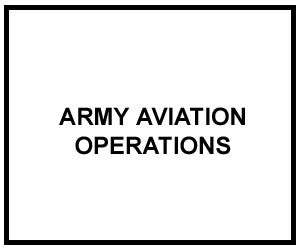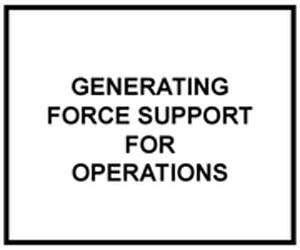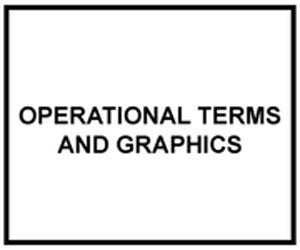
FM 1-100: ARMY AVIATION OPERATIONS
Official US Army Field Manual in Acrobat PDF file format.
Field Manual (FM) 1–100 is Army aviation’s capstone manual. It embodies the doctrinal tenets for the employment of aviation and establishes the basis for understanding aviation as an essential element of combat power. Doctrinally describing Army aviation, the manual serves as the foundation that captures the essence of Army aviation and those principles upon which it is employed. It prescribes doctrine above the level of tactics, techniques, and procedures.
This field manual provides general guidance concerning the employment of Army aviation on the modern battlefield. It forms the basis for understanding Army aviation’s unique contribution to maneuver, combat support, and combat service support missions. It establishes the principles of Army aviation employment for warfighting and other operations, and applies to all echelons of aviation operations. This manual is intended for use by Aviation commanders, staff officers, and all soldiers within aviation units and theater, corps, division, and brigade commanders and their staffs. It applies to all members of the combined arms team; joint, multinational, and interagency operations; and special operations, or contingency, forces that operate with Army aviation forces.
This edition of FM 1–100 is written to carry Army aviation forward to the turn of the century. Our vision lies beyond the turn of the century, however. As this manual is
being drafted and staffed, we are concurrently developing the new concepts that will
evolve into the doctrinal foundation for the next century. This is a dynamic period of
innovation and change.
Our leap–ahead reconnaissance and attack aircraft—the RAH-66 Comanche and AH-64
Longbow Apache—are realities. We know their current capabilities, and can envision the
future potential they bring to the future battlefield. We are developing future doctrine
based on those capabilities. At the same time, the research and development community
and industry continue to create the enabling technologies-the digital communications
and other linkages—we need to fight these systems to their fullest potential. The future
battlespace will be fluid, high tempo, and nonlinear. The traditional battlefield framework
of deep, close, and rear operations will become increasingly convoluted and ambiguous.
To maintain continuity with other capstone Army doctrine, this edition of FM 1–100 will
continue to refer to close, deep, and rear operations; however, in the near future, a more
viable framework may be simply close and extended operations. On the nonlinear/noncontiguous battlefield of the future, we must be prepared to conduct seamless, simultaneous operations in all directions.
Army operations will be conducted in the context of an ever-changing world. No longer
can we model the force and develop our doctrine against one known threat, or even
counter the capabilities of a number of known potential adversaries. Instead, we must
develop and retain the warfighting capability to win decisively across the spectrum of
operations with minimum friendly casualties. This is domination–based warfare-massing
not only our forces, but total lethal and nonlethal effects, throughout the battlespace
to dominate any potential adversary. Army aviation is uniquely suited to these challenges.
The Apache and Comanche fully exemplify the inextricable linkage between maneuver
and fires. With unmanned aerial vehicles (UAVs) to extend their range and coveragedigitally cued by the Joint Surveillance Target Attack Radar System (JSTARS), Army airborne command and control system (A2C2S) UH–60 Black Hawks, and other ground–based command posts—these aircraft provide commanders with real–time intelligence and situational awareness. They maneuver throughout the depth of the battlespace to deliver precision fires with devastating lethality.
Shaping Army aviation for future operations is more than merely delivering lethal fires
...it is more than killing enemy tanks and artillery.. .it is, instead, creating a new
synergy—a total integration into what is termed a pattern of operations. (The subsets of
the pattern are depicted in italics to indicate that they are emerging doctrinal terms.)
Our future Aviation units will be modular and deployable. They will provide joint force
commanders with a lethal and flexible force to rapidly deploy from the continental United
States (CONUS), or abroad, to any theater. Deployment will be by strategic air or sea lift,
self-deployment, with a maritime force aboard aircraft carriers, or by any combination of
those means.
No other force can match Army aviation’s ability to rapidly project the force and build
combat power in an immature theater. Once on the ground, we become the principal
means to protect the force as the other ground forces continue to deploy and flow into the
initial lodgement. This is best exemplified by the initial days and weeks of Desert Shield
as aviation units quickly deployed to Saudi Arabia and became the principal combat
power for the initial covering force.
Throughout the future fight, Army aviation will be at the forefront of gaining information
dominance. The Comanche and Longbow Apache, coupled with UAVs and the A2C2S
UH–60, form a team that becomes, in effect, the command, control, communications, and
intelligence (C3I) key facilitator for the future battlefield. We can eliminate the enemy’s
reconnaissance, attack his command and control (C2), and gather intelligence, while
providing security for our own intelligence and C2 systems. Digitally cued by JSTARS and other airborne and ground sensors, our future aircraft will add a new dimension of
precision economy of force. Concurrently, these missions also contribute to Army
aviation’s key role in shaping the battlespace.
By conducting armed reconnaissance and security missions with real–time, sensor–toshooter linkages, Army aviation can rapidly confirm the enemy’s intentions, disrupt his
tempo, deny his freedom of action, and get into his decision cycle. The ultimate in
shaping the battlespace is to preclude the necessity for conducting decisive operations.
We can sustain the tempo of the fight, attacking with depth and simultaneity throughout the battlespace. At a time and place of our choosing, we will initiate decisive operations
in conjunction with maneuver ground forces to complete the destruction or defeat of
enemy forces.
We will sustain the force and transition to future operations with combat support and
combat service support provided by our UH–60 Black Hawk and CH–47 Chinook aircraft, and by air assaulting forward-operating bases from which follow–on combat operations can be conducted. We will also continue to provide the reconnaissance, security, and attack helicopter support to sustain the fight and protect the force as we prepare for follow–on operations.
Army aviation must adapt quickly to the inevitable changes that affect our mission. Our
doctrine, tactics, techniques, and procedures must reflect those changes and be responsive to the needs of our units in the field. We encourage your comments and ideas as we develop our collective vision for shaping the future of Army aviation.
File download size: 1.5 MB



